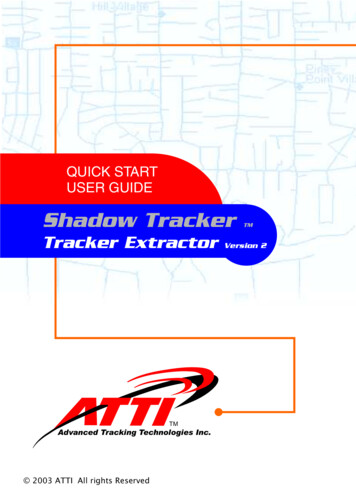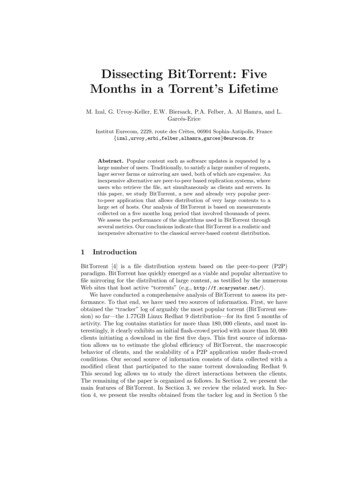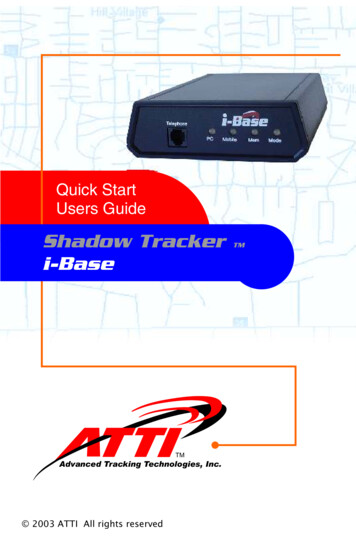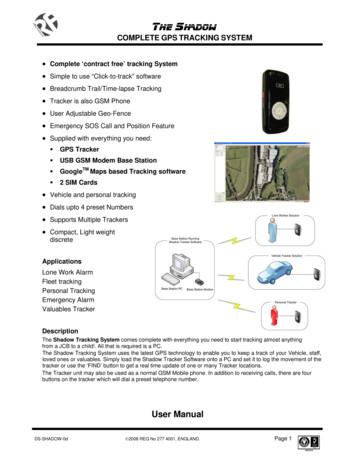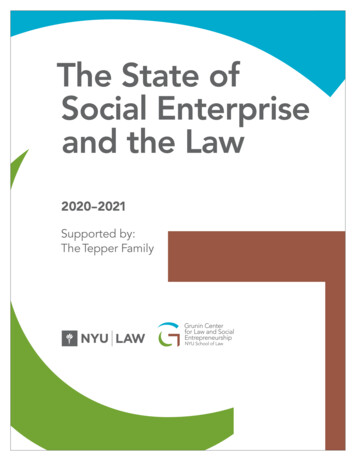Transcription
May 29, 2013State Medicaid Integration TrackerMay 2013 Edition
State Medicaid Integration TrackerWelcome to the State Medicaid Integration Tracker The State Medicaid Integration Tracker is published each month by the NationalAssociation of States United for Aging and Disabilities (NASUAD).Newinformation presented each month is highlighted in purple.The State Medicaid Integration Tracker focuses on the status of following stateactions:1. Managed care for people who receive Medicaid-funded long-term servicesand supports (LTSS)2. State Demonstrations to Integrate Care for Dual Eligible Individuals (StatusChart) and other Medicare-Medicaid Coordination Initiatives3. Other LTSS Reform Activities, including:Balancing Incentive Program (BIP)Medicaid State Plan amendments under §1915(i)Communities First Choice Option under §1915(k)Health HomesNASUAD uses many sources of information to find out what is happening acrossthe country, including CMS MLTSS resource website, Medicaid.gov, state websites,Bureau of National Affairs (BNA) State’s Healthcare Regulatory Developments,Integrated Care Resource Center website, Kaiser Family Foundation newsletters andpublications, newsletters from National Association of Medicaid Directors, newsreports, and presentations by states. Sources are listed for each item, and readerswill find hyperlinks for related documents and materials provided by CMS andstates.For more information, please contact Mike Hall (mhall@nasuad.org) or Eunhee(Grace) Cho (gcho@nasuad.org)State Medicaid Integration Tracker May 20132
State Medicaid Integration TrackerSummaryState ActionsBoth Medicaid Managed LTSS andMedicare-Medicaid Care CoordinationInitiativeCA, DE, FL, IL, MA, MI, MN, NH, NJ, NY,NC, OH, TX, WA, WIMedicaid Managed LTSS Only:AZ, HI, KS, NM, PA, TNMedicare-Medicaid Care CoordinationInitiative:AZ(W), CA*, CO, CT, DE, FL**, HI(W), ID,IL*, IA, IN**, MA*, MI, MN(W)**, MO,NH**, NJ**, NM(W), NY, NC, OH*, OK,OR(W), RI, SC, TN(W), TX, VA*, VT, WA*,WI*: Financial Alignment (FA) demonstrationproposal approved by CMS**: Initiatives other than FA demonstrationW: No longer pursuing FA demonstrationState Medicaid Integration Tracker May 2013(Duals Demonstration Status Chart)3
State Medicaid Integration TrackerSummary (Continued)State ActionsOther LTSS Reform Activities (*Approved by CMS):Balancing Incentive Program: AR*, CT*, GA*, IA*, IN*, LA*, MD*, MO*, MS*,NH*, NJ*, NY*, TX*Section 1915(i) State Plan Amendment: CA, CO, CT, DC, DE, FL, IA, ID, IN, LA,MD, MN, MT, NC (2), NV, OR, TX (W), WISection 1915(k) Community First Choice: AZ, CA*, CO, LA, MD, MN, MTHealth Homes: AL*, AR, AZ, CA, DC, IA* (1 approved; 1 pending), ID*, IL, IN,KS, MA, MD, ME*, MI, MO (2)*, MS, NC*, NJ, NM, NV, NY*, OH*, OK, OR*, RI(2 approved; 1 pending), SD, VT, WA, WI*, WVState Medicaid Integration Tracker May 20134
State Medicaid Integration TrackerState UpdatesStateAlabamaState UpdatesHealth HomesCMS approved the Agency’s request to implement its proposed health homesprogram. Under this program, the State will implement comprehensive caremanagement in four networks. CMS approval allows the State to draw down 90%FMAP for a two-year period between July 1, 2012, and June 30, 2014. Targetpopulation includes individuals with two chronic conditions, one and at risk foranother or SMI, i.e., all the conditions listed in §2703 of the ACA, except BMI over25. Other chronic conditions include transplants, CVD, cancer, COPD, sickle cellanemia, HIV. (Source: Alabama Medicaid Agency News, May 7, 2013; ApprovedHealth Homes State Plan Amendment)Approved Health Homes State Plan Amendment (Approved 4/9/2013)ArizonaCurrently Operating Medicaid Managed LTSS ProgramUnder Medicaid Section 1115 waiver authority, Arizona Health Care CostContainment System (AHCCCS) provides health care services through a prepaid,capitated managed care delivery model that operates statewide for both MedicaidState plan groups as well as demonstration expansion groups. The goal of thedemonstration is to provide organized and coordinated health care for both acuteand long-term care that includes pre-established provider networks and paymentarrangements, administrative and clinical systems for utilization review, qualityimprovement, patient and provider services, and management of health services.Beneficiaries receiving long-term care services receive additional benefits thatwould not otherwise be provided through the Medicaid State plan. (Source:Medicaid.gov)State Website on AHCCCSFact SheetCurrent Approval Document (4/6/2012)Rate reductions were instituted for the 2011-2012 contract year for virtually allinstitutional and non-institutional services covered under AHCCCS. The Statereleased (8/10/2012) final rule of the AHCCCS to maintain reimbursementreductions for inpatient and outpatient hospital services covered through theAHCCCS program that were instituted last contract year (October 1, 2011 throughSeptember 30, 2012) and to eliminate adjustments to those rates based on inflation.(Source: BNA Register, August 17, 2012)The State recently submitted (11/9/2012) amendment to its 1115 Waiver to extendthe State’s authority (1) to provide Medicaid coverage to adults without dependentchildren with incomes between 0% and 100% of the Federal Poverty LevelState Medicaid Integration Tracker May 20135
State Medicaid Integration TrackerStateArizonaState Updates(“Childless Adults”) for the entire period of its Demonstration, and (2) to obtain theenhanced federal medical assistance percentage (FMAP) for Childless Adultsbeginning January 1, 2014. No changes to the benefit package or to the current costsharing requirements are being proposed through this amendment.Application for amendment (11/9/2012)State Demonstration to Integrate Care for Dual Eligible Individuals (Withdrawn)On April 10, AHCCCS Director Thomas Betlach submitted a letter withdrawing theState’s proposal to participate in the CMS Capitated Financial AlignmentDemonstration for members that have AHCCCS and Medicare. Arizona willcontinue to work with the CMS Medicare-Medicaid Coordination Office to improvethe system for dually-eligible members through the current managed care modelby leveraging D-SNPs. (Source: State Website)Arizona Capitated Financial Alignment Demonstration Withdrawal Letter(4/10/2013)According to proposal submitted to CMS on May 31, 2012, the State’sdemonstration was to be statewide and would use a capitated payment model.Target population included full benefit Medicare dually-eligible enrollees withMedicare A and/or B who are Medicaid-eligible through: (1) the Arizona LongTerm Care System Elderly and Physically Disabled (ALTCS E/PD) program; (2) theacute care program or (3) as an acute care enrollee with Serious mental illnessresiding in Maricopa County, a subset of the acute care program. While thedemonstration included almost the entire dually-eligible population in the State,persons with intellectual or developmental disabilities (I/DD population) werefully carved out. Members who are eligible for ALTCS through the Department ofEconomic Security/Division of Developmental Disabilities were not to be eligiblefor enrollment in the demonstration at this time. Covered benefits includedMedicare Parts A, B, and D, Medicaid State Plan and 1115 Waiver (as applicable),and Medicare Supplemental benefits. Proposed implementation date was January1, 2014. (Source: Demonstration Proposal)Section 1915(k) Community First Choice (CFC) OptionArizona submitted application for Community First Choice Option to CMS,targeting Fall 2012 for implementation.Arizona Long Term Care System (ALTCS) Update (5/16/2012)Health HomesThe Arizona Department of Health Services/Division of Behavioral Health Services(ADHS/DBHS) and the Arizona Health Care Cost Containment System (AHCCCS)were awarded (3/29/2011) a planning grant to explore the feasibility of a RegionalState Medicaid Integration Tracker May 20136
State Medicaid Integration TrackerStateArizonaState UpdatesBehavioral Health Authority (RBHA) model with expanded responsibility for TitleXIX-eligible adults determined to have a Serious mental illness (SMI). This RBHAmodel is referred as "Recovery through Whole Health". This RBHA is funded forand fully responsible for coordinated and integrated behavioral healthcare andphysical healthcare for Title XIX-eligible adults with SMI through the use of HealthHomes Services. It is based on the goals, principles and concepts contained in theHealth Home provisions in Section 2703 of the Affordable Care Act. (Source: StateWebsite on Health Homes)Arizona Health Care Cost Containment System (AHCCCS) Director Testifiesbefore the U.S. Senate on Duals DemonstrationOverviewComplete TestimonyArkansasBalancing Incentive ProgramThe Centers for Medicare & Medicaid Services (CMS) announced (3/15/2013) thatArkansas will receive an estimated 61.2 million in enhanced Medicaid funds (2%enhanced FMAP rate). (Source: Balancing Incentive Program Award Letter)BIP Application (11/27/2012); BIP Award Letter (3/15/2013)Health HomesCMS approved planning request. (Source: Integrated Care Resource Center)CaliforniaCurrently Operating Medicaid Managed LTSS ProgramUnder Medicaid Section 1915(a) authority, SCAN Connections at Home provideslong-term services and supports (LTSS) to Medicare-Medicaid enrollees of age 65and older at capitated rate. Services include nursing facility and HCBS waiver-likeservices, including homemaker, home delivered meals, personal care,transportation escort, custodial care, in-home respite, and adult day. The programoperates in limited geographic area and enrollment is voluntary. (Source: CMS andTruven Health Analytics, The Growth of Managed Long-Term Services andSupports (MLTSS) Programs: A 2012 Update, July 2012)State Website on SCAN Connections at HomeState Demonstration to Integrate Care for Dual Eligible IndividualsCoordinated Care Initiative (CCI): California submitted a revised demonstrationproposal to CMS on May 31, 2012. On June 27, 2012, the governor approved a bill(SB 1008) to revise the existing law to require the Department of Health CareServices to establish demonstration sites in up to eight counties not sooner thanMarch 1, 2013. (Source: Calduals.org, July 3, 2012) According to thedemonstration proposal, target population includes all full benefit Medicare-State Medicaid Integration Tracker May 20137
State Medicaid Integration TrackerStateCaliforniaState UpdatesMedicaid enrollees who are age 21 or over in eight counties with specifiedexceptions. Full benefit dually-eligible beneficiaries are those Medicarebeneficiaries with Parts A, B, and D coverage and full Medi-Cal coverage. Medi-Calcovers Medicare premiums, co-insurance, copayments, and deductibles, as well asservices that Medicare does not cover (primarily long-term services and supports).Beneficiaries with developmental disabilities who are receiving services from theDepartment of Developmental Services and regional centers are carved out fromthe demonstration, while some people with developmental disabilities receivingservices through the State's in-home supportive services (IHSS) and communitybased adult services (CBAS) will be included in the demonstration. Those enrolledin 1915(c) HCBS waiver programs are also excluded from the demonstration.Covered benefits include Medicare (Parts A, B and D) and Medicaid coveredservices. The demonstration will use a capitated payment model. (Source:Demonstration Proposal; NASDDDS Managed Care Tracking Report) Stateofficials proposed (05/25/2012) a change in the implementation date, from March2013 to June 2013. (Source: www.californiahealthline.org, May 30, 2012)Demonstration ProposalState Website on Coordinated Care InitiativeTimelineCoordinated Care Initiative Fact Sheets on CalDuals.orgCMS announced on March 27, 2013 that California would be the fifth state to enterinto a Memorandum of Understanding (MOU) to integrate care for dually-eligiblebeneficiaries as a component of California’s Coordinate Care Initiative (CCI).According to the State’s website, the project will be called the Cal MediConnectfrom now on. Through Cal MediConnect, eligible beneficiaries will have theopportunity to combine all their Medicare and Medi-Cal benefits into one healthplan — and receive more coordinated and accountable care. Enrollment wasinitially expected to begin no sooner than October 1, 2013. On May 6, 2013,however, the Department of Health Care Services (DHCS) announced that CalMediConnect would begin no earlier than January 2014. (Source: CalDuals,accessed 5/13/2013)Memorandum of UnderstandingSection 1915(k) Community First Choice (CFC) OptionCalifornia is the first state to receive approval from CMS (9/4/2012) to enact theCommunity First Choice Option, which will provide the state an estimated 573million in additional federal funds during the first two years of implementation.Community First Choice will enhance Medi-Cal’s ability to provide communitybased personal attendant services and support to seniors and persons withdisabilities to certain enrollees who otherwise would need institutional care.California immediately will begin claiming the Community First Choice federalfunding, which is retroactive for most In-Home Supportive Services (IHSS)State Medicaid Integration Tracker May 20138
State Medicaid Integration TrackerStateCaliforniaState Updatesprogram services provided since December 1, 2011.Press Release (9/4/2012)State WebsiteLetter to County Welfare Directors and In-Home Supportive Services ProgramManagersSection 1915(i) State Plan AmendmentCalifornia Department of Health Care Services (DHCS) submitted two 1915(i) stateplan amendments in 2011. The first one proposes to target developmentallydisabled individuals with a need for habilitation services. This SPA will extendMedi-Cal coverage for existing specialized health and other HCBS provided toMedi-Cal-eligible persons with developmental disabilities. Medi-Cal-eligiblepersons with developmental disabilities who do not meet the criteria forinstitutional long-term care services will be covered under this State Plan option.Services to be provided would include community living arrangement services,respite care, and day services. The state anticipates serving 42,000 in the first year.The second one proposes to target infants and toddlers with developmental delaysand would provide a 1-day session with families to prepare the children for schoolor other appropriate facilities, which is currently funded with state-only funds.California anticipates serving 3,800 in the first year. (Source: U.S. GovernmentAccountability Office. States' Plans to Pursue New and Revised Options for Homeand Community-Based Services. June 2012) The State implemented the optionprior to FY2012. (Kaiser Commission on Medicaid and the Uninsured, April 2013)Health HomesCMS approved planning request. (Source: Integrated Care Resource Center)ColoradoState Demonstration to Integrate Care for Dual Eligible IndividualsColorado’s demonstration will include the State’s entire dually-eligible population,including those with I/DD, with enhanced coordination between acute and longterm care. (Source: NASDDDS Managed Care Tracking Report) The demonstrationis statewide with managed fee-for-service as the payment model. Covered benefitsinclude Medicare Parts A, B, and D, Medicaid State Plan, Behavioral HealthServices available under an existing 1915(b) Medicaid waiver, and Home andCommunity-Based Services available under 1915(c) Medicaid waivers.Implementation date was not specified. (Source: Demonstration Proposal)State Website on Duals DemonstrationSection 1915 (i) State Plan AmendmentColorado operates program under Section 1915(i) State Plan Amendment. (Source:NASUAD’s interview with a State official)State Medicaid Integration Tracker May 20139
State Medicaid Integration TrackerStateColoradoState UpdatesAccountable Care Collaborative (ACC)A bipartisan bill, which establishes a program to pilot-test Medicaid fee-for-servicealternatives and Regional Care Collaborative Organizations (RCCO), was signedinto law by Governor John Hickenlooper (6/4/2012). (Source: ModernHealthcare.com; ModernPhysician.com) According to the state website, Medicaid clients in theAccountable Care Collaborative (ACC) will receive the regular Medicaid benefitpackage, and will also belong to a “Regional Care Collaborative Organization”(RCCO). The Regional Care Collaborative Organization (click here for stateresource) connects Medicaid clients to Medicaid providers by helping Medicaidclients find community and social services in their area and providers communicatewith Medicaid clients and with each other. A RCCO will also help Medicaidclients get the right care when they are returning home from the hospital or anursing facility, by providing the support needed for a quick recovery. A RCCOhelps with other care transitions too, like moving from children’s health services toadult health services, or moving from a hospital to nursing care. All clients enrolledin the ACC also have to choose Primary Care Medical Provider (PCMP). PrimaryCare Medical Provider (click here for state resource) is a Medicaid client's mainhealth care provider. A PCMP is a Medicaid client's “medical home,” where he orshe will get most of their health care. When a Medicaid client needs specialistcare, the PCMP will help him or her find the right specialist.Accountable Care Collaborative State WebsiteAccountable Care Collaborative Fact SheetSelected by the Center's for Medicare and Medicaid Services' (CMS') InnovationCenter to participate in the Comprehensive Primary Care (CPC) Initiative, the Statewill implement this new primary care initiative through the existing ACC Program.The CPC Initiative is focused on strengthening primary care and fosteringcollaboration between health care systems. (Source: Colorado Department ofHealth Care Policy and Financing)Section 1915(k) Community First Choice OptionThe State is currently considering pursuing the option. In 2012, Colorado's LongTerm Services and Supports (LTSS) Strategic Planning Report identified consumerdirection/Community First Choice as an important initiative within the strategy ofLTSS. In accordance with the federal final rule on the option, Community FirstChoice Council has been formed. (Source: Colorado Community First ChoiceCouncil website)ConnecticutState Demonstration to Integrate Care for Dual Eligible IndividualsConnecticut’s financial alignment demonstration proposes to serve dually-eligible(MMEs) age 18 to 64, and age 65 and older. The populations served will includeState Medicaid Integration Tracker May 201310
State Medicaid Integration TrackerStateConnecticutState Updatesindividuals with Serious mental illness (SMI), and individuals with Intellectual andDevelopmental Disabilities, with increased coordination focused on acute healthcare. (Source: NASDDDS Managed Care Tracking Report) Covered benefits includeMedicaid State Plan services (including 1915(i)), Medicaid waiver services,Medicare Parts A, B and D, and adjunct services and supports, such as IntensiveCare Management, chronic disease self-management education, nutritioncounseling, falls prevention, medication management services, and potentially also,peer support and recovery assistance. The demonstration will utilize a managedfee-for-service payment model. Participation of MMEs in the AdministrativeServices Organization (ASO) model will begin statewide effective January 1, 2013.Participation of MMEs in Health Neighborhoods (HN) model will be launched on apilot basis in limited service areas starting April 1, 2013. The Department thenplans to use the knowledge gained in this pilot period to expand the initiative toserve additional MMEs, and also potentially to expand the model to serve singleeligible Medicaid individuals (MEs) and convert risk-adjusted advanced paymentsto HNs (APM II) to a Health Homes coverage option. (Source: DemonstrationProposal)Balancing Incentive ProgramThe Centers for Medicare & Medicaid Services (CMS) announced (12/7/2012) thatConnecticut will receive an estimated 72.8 million in enhanced Medicaid funds(2% enhancement of the State’s FMAP rate). (Source: CMS Balancing IncentiveProgram website)CMS Award Announcement (12/7/2012)BIP Application (10/31/2012)Section 1915(i) State Plan AmendmentConnecticut has submitted application for Section 1915(i) State Plan Option.(Source: NASUAD) The target populations are elderly and disabled individuals,including older adults financially, but not functionally eligible for the State’s HCBSelder waiver. The services covered by the option are adult day health, caremanagement, homemaker, personal care assistant, respite, assisted living, assistivetechnology, chore services, companion, environmental accessibility adaptations,home delivered meals, mental health counseling, personal emergency responsesystems, and transportation. Effective date is February 1, 2012. (Source: 1915(i) StatePlan Amendment application; Kaiser Commission on Medicaid and the Uninsured,April 2013)Connecticut restructures the state’s relationships with Medicaid managed careplansStarting January 1, 2012, Connecticut began directly reimbursing health careState Medicaid Integration Tracker May 201311
State Medicaid Integration TrackerStateState UpdatesConnecticutproviders, while a non-profit organization, Community Health Network ofConnecticut, Inc., provides care coordination and customer service for all of thestate’s Medicaid and Children’s Health Insurance Program beneficiaries, plusmembers of a state-funded health programs for low-income adults — about 600,000people in all. All services will be coordinated by the Department of Social Services’single, statewide administrative services organization (ASO). (Source: Stateline;Community Health Network of Connecticut, Inc.)Press ReleaseRequest for Proposals (April 2011)HB06518. An Act Establishing An Administrative Services OrganizationDelawareCurrently Operating Medicaid Managed LTSS Program & State Initiatives toIntegrate Care for Dual Eligible IndividualsAmendment to Diamond State Health Plan (DSHP) Section 1115 Medicaidmanaged care demonstration waiver (approved 3/22/2012) added Diamond StateHealth Plan Plus (DSHP Plus) in order to integrate Long Term Care Medicaid andother full-benefit dually eligible into the DSHP. DSHP Plus began on April 1, 2012.Services provided in capitated rate include primary, acute, and behavioral services,and LTSS. Prescription drugs are carved out of both DSHP and DSHP Plus. Targetpopulation includes older persons, persons with physical disabilities, persons withHIV/AIDS, persons using Money Follows the Person services, workers withdisabilities using Buy-in, Medicare-Medicaid enrollees, and all SSI-eligible childrenand adults except persons in ICF/MRs and persons in DD/MR 1915(c) waiver. Theamendment also consolidates Elderly/Disabled, Acquired Brain Injury, andAssisted Living 1915(i) waivers into one Elderly and Disabled waiver program.Elderly and Disabled waiver program and AIDS/HIV waiver will be incorporatedinto the long-term care managed care program. (Source: Medicaid.gov; DSHP FactSheet)Waiver Amendment Request Letter to CMSCurrent Approval DocumentDiamond State Health Plan websiteFinal rule of the Department of Health and Social Services, Division of Medicaidand Medical Assistance, amends and adopts regulations regarding the DiamondState Health Plan (DSHP) Section 1115 Medicaid managed care demonstrationwaiver. The rule expands the DSHP to include Long-Term Care Medicaid andother full-benefit dual eligible beneficiaries under the name Diamond State HealthPlan Plus. The rule is effective June 10, 2012. For more information, please clickhere. (Source: BNA Register, 6/12/2012)Section 1915(i) State Plan AmendmentThe State plans to implement the option in FY 2013. (Source: Kaiser Commission onMedicaid and the Uninsured, April 2013)State Medicaid Integration Tracker May 201312
State Medicaid Integration TrackerStateDistrict ofColumbiaState UpdatesSection 1915(i) State Plan AmendmentAccording to a DC official, the District is looking to develop and implement the1915(i) state plan option in the Affordable Care Act for its Day Treatment program,and is currently engaged in conversations with CMS technical assistance contractorto determine how the District can best use the 1915(i) option in its effort to bringDay Treatment service delivery into compliance. Target population will includeolder adults, adults with physical disabilities adults with mental illness, and adultswith intellectual and developmental disabilities. (Source: NASUAD)Health HomesCMS approved planning request. (Source: Integrated Care Resource Center)FloridaCurrently Operating Medicaid Managed LTSS ProgramFlorida Long-term Care Community Diversion Program operating under 1915(a)and 1915(c) Medicaid authorities serves Medicare-Medicaid dual eligibles of age 65and older in 46 of 67 counties in the State. The State is currently processingapplications for the remaining counties. Enrollment is voluntary with opt in.(Source: CMS and Truven Health Analytics, The Growth of Managed Long-TermServices and Supports (MLTSS) Programs: A 2012 Update, July 2012)State Website on Long-term Care Community Diversion ProgramApproved WaiverProjected Medicaid Managed LTSS Program & State Initiatives to Integrate Carefor Dual Eligible IndividualsThe Florida Agency for Health Care Administration (AHCA) recently (2/1/2013)received approval of its application for a 1915(b)(c) combination waiver from CMSto implement the long-term care component of the State Medicaid Managed Care(SMMC) Program. These simultaneous (b) & (c) waivers are effective beginningJuly 1, 2013, through June 30, 2016. The Agency had submitted (8/1/2011) initial1915(b) waiver application and a concurrent initial 1915(c) waiver application to theCMS to implement the Florida Long Term Care Managed Care program asmandated by the 2011 Florida Legislature (House Bill 7107). The legislaturerequired the agency to create a statewide long-term care managed care program forMedicaid recipients who are (a) 65 years of age or older, or age 18 or older andeligible for Medicaid by reason of a disability; and (b) determined to requirenursing facility level of care. The specific authorities requested in the 1915(b) and(c) waiver applications will allow the State to require eligible Medicaid recipients toreceive their nursing facility, hospice, and home and community based (HCB)services through long term care (LTC) plans selected by the State through acompetitive procurement process. With the implementation of Florida Long TermCare Managed Care, five of Florida’s current HCBS waivers will be phased out, andState Medicaid Integration Tracker May 201313
State Medicaid Integration TrackerStateFloridaState Updateseligible recipients (older persons or adults with physical disability who meetnursing facility level of care) will receive HCBS through a the new 1915(c) FloridaLong Term Care Managed Care Program waiver that will operate concurrentlywith the 1915(b) Florida Long Term Care Managed Care Program. The Agency hasbegun implementation, and must complete statewide implementation by October 1,2013. Mandatory enrollment populations include Medicare-Medicaid dual eligibles(fee-for-service). (Source: Florida Long-term Care Managed Care Program Website;CMS and Truven Health Analytics, July 2012)Approval letter (2/1/2013)Section 1915(b) waiver applicationSection 1915(c) waiver applicationFlorida Long-term Care Managed Care Program websiteFlorida Long-Term Care Managed Care Program OverviewFlorida AHCA Long-term Care (LTC) Managed Care Invitation to Negotiate (ITN)Attachment D (12/28/2012)Technical Advisory Workgroup Final Report (8/21/2012)Florida Medicaid Reform—Section 1115 Demonstration Waiver (Approved12/15/2011)Under Florida Medicaid Reform waiver, most Medicaid beneficiaries in fivecounties are required to enroll in a managed care plan (either a capitated healthplan or a fee-for-service Provider Service Network plan) as a condition of eligibilityfor Medicaid. Participation is mandatory for TANF-related populations. Voluntaryparticipants include individuals residing in an institution such as a nursing home,sub-acute inpatient psychiatric facility for individuals under the age of 21, or anICF-DD; dually-eligible individuals; and individuals with developmentaldisabilities. (Source: Medicaid.gov, Fact Sheet)Fact SheetCurrent Approval DocumentMedicaid Reform waiver websiteLetter to CMS - Medicaid Managed Care Policies (10/13/2012)Section 1915(i) State Plan AmendmentThe State implements the optional 1915(i) State plan Home and Community-BasedServices (HCBS) benefit for delinquent youth with serious emotional disturbancesand their families. The operating agency is the Department of Juvenile Justice.State Plan AmendmentGeorgiaBalancing Incentive ProgramThe Centers for Medicare & Medicaid Services (CMS) announced (6/13/2012) thatGeorgia will receive estimated 64.4 million of enhanced Medicaid funds (2%enhanced rate). Approved work plan is available here. (Source: CMS BalancingState Medicaid Integration Tracker May 201314
State Medicaid Integration TrackerStateGeorgiaState UpdatesIncentive Program website)CMS Award Announcement (6/13/2012)Balancing Incentive Program Grant Application (Submitted to CMS 3/3/2012)Medicaid & CHIP Redesign InitiativeThe state-commissioned report by a consultant recommended moving all people inMedicaid into managed care. That would include those in nursing homes andpeople with disabilities, who are currently in a traditional fee-for-service system.The Department of Community Health, which runs Medicaid and PeachCare,expressed interest in protecting UPL in a manner similar to Texas and California,should the program be changed to "full-risk" managed care. Under UPL, the stateis able to get a higher reimbursemen
State Website on AHCCCS Fact Sheet Current Approval Document (4/6/2012) Rate reductions were instituted for the 2011-2012 contract year for virtually all institutional and non-institutional services covered under AHCCCS. The State released (8/10/2012) final rule of the AHCCCS to maintain reimbursement
